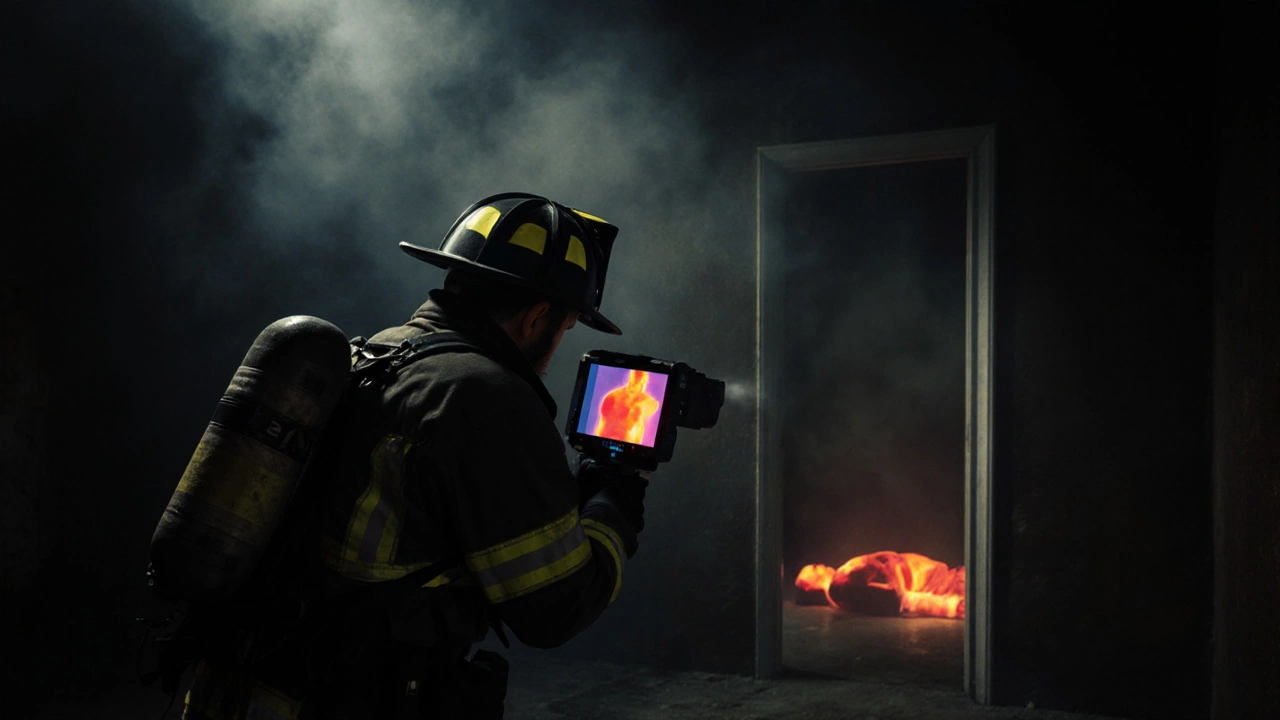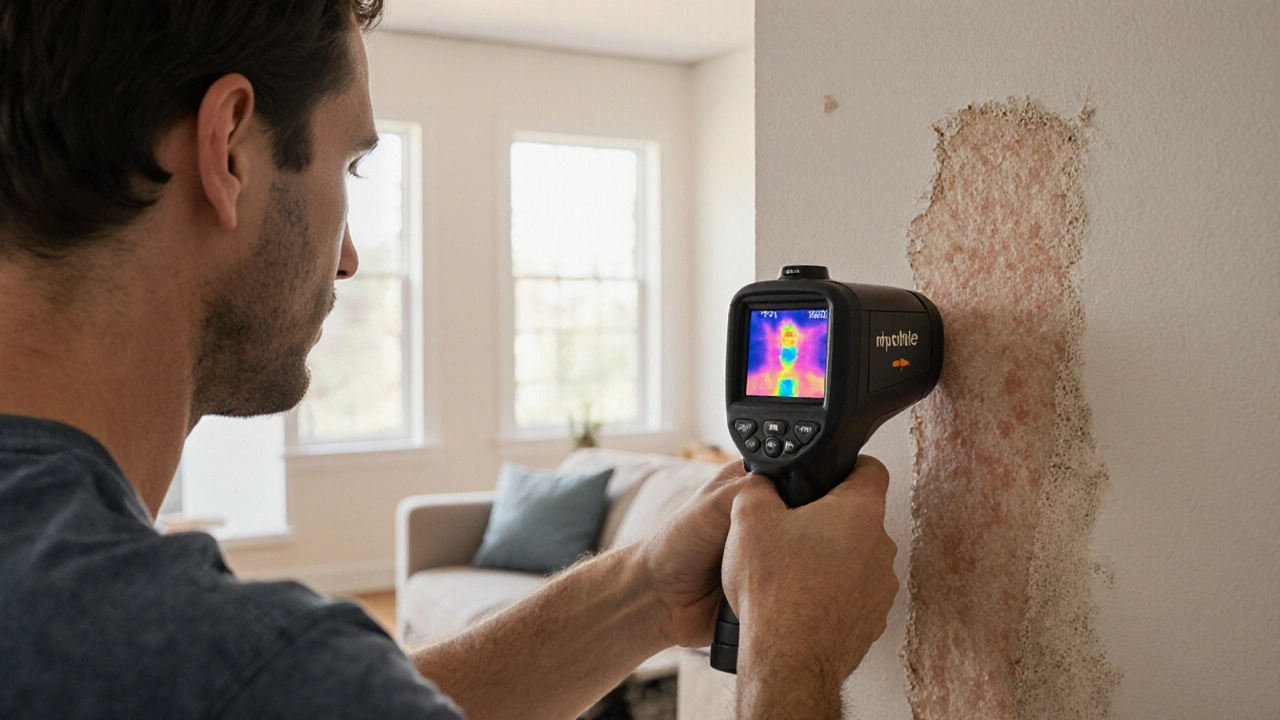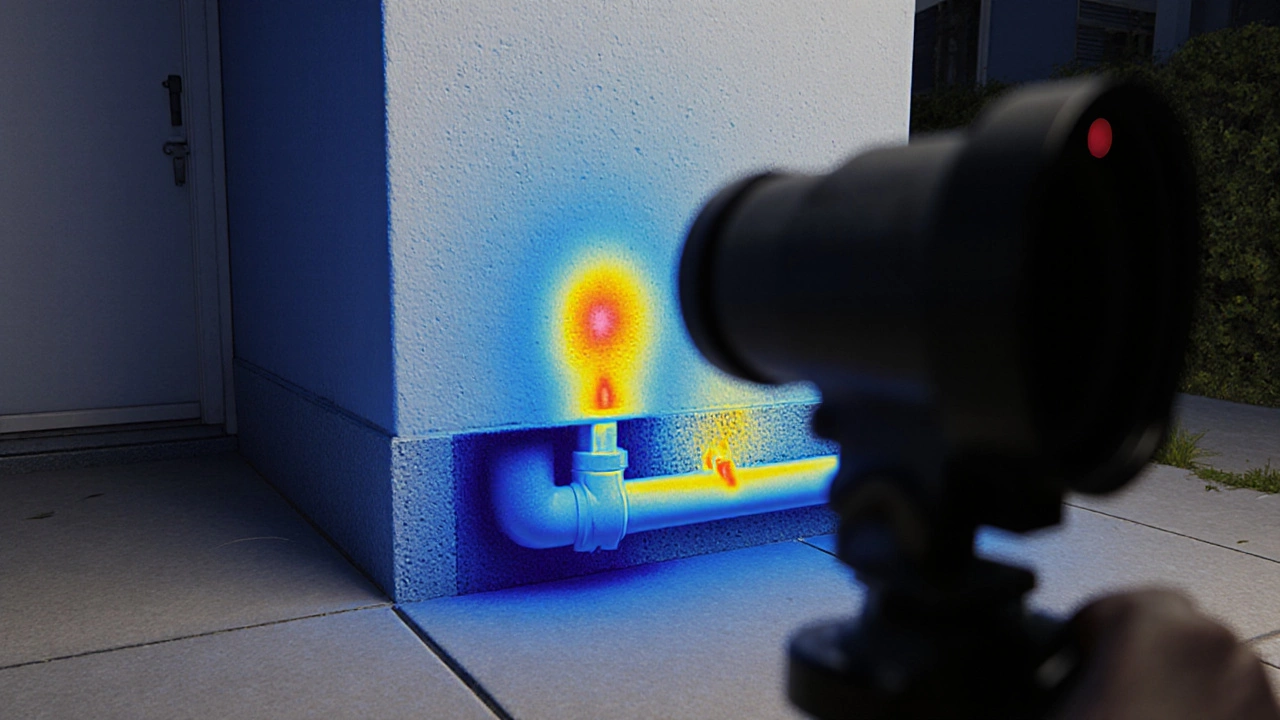People often think thermal cameras can see through walls like in the movies-detecting a person hiding behind a brick wall or spotting someone in the next room. But that’s not how thermal imaging works. Thermal cameras don’t see through walls. They don’t have X-ray vision. They don’t magically reveal what’s on the other side of a door or drywall. What they actually do is detect surface heat.
How Thermal Cameras Actually Work
Thermal cameras capture infrared radiation-the heat that all objects naturally give off. Everything warmer than absolute zero emits some level of infrared energy. These cameras are tuned to pick up wavelengths between 7.5 and 15 micrometers, known as the long-wave infrared (LWIR) range. That’s the sweet spot for detecting body heat, engine warmth, or even a warm pipe behind a wall.
But here’s the key: thermal cameras only see the surface they’re pointed at. When you point one at a wall, it sees the temperature of the wall’s surface-not what’s behind it. Concrete, brick, wood, drywall, even insulation-all of these block infrared radiation. The heat from a person on the other side of the wall doesn’t shoot through like a bullet. It slowly conducts through the material, maybe warming up a small patch of the wall’s surface. That’s not seeing through. That’s detecting a side effect.
Why Hollywood Got It Wrong
Think about action movies where the hero points a glowing device at a wall and instantly sees a bad guy crouching behind it. That’s pure fiction. Real thermal imaging doesn’t work that way. Even high-end military-grade systems can’t penetrate solid walls. The physics just doesn’t allow it. Infrared radiation can’t pass through dense, solid materials the way radio waves or X-rays sometimes can. Walls aren’t transparent to heat-they’re barriers.
FLIR Systems, one of the biggest names in thermal tech, has been clear about this since 2023: “Thermal cameras cannot see through walls, at least not like in the movies.” And they’re not alone. Armasight, Voltrium Systems, and other industry leaders all say the same thing. The myth persists because it’s dramatic. But it’s not real.
What Thermal Cameras *Can* Detect Near Walls
Just because thermal cameras can’t see through walls doesn’t mean they’re useless for wall inspections. In fact, they’re incredibly useful for finding hidden problems-just not hidden people.
Here’s what they *can* detect:
- Heat from electrical wiring: If a wire is overloaded or faulty, it heats up. That heat can transfer to the drywall, showing up as a warm spot on the surface.
- Water leaks: Wet insulation or damp drywall cools down as water evaporates. That creates a cold patch on the wall-even if the leak is inside the cavity.
- Missing insulation: In winter, areas without insulation stay colder than well-insulated spots. Thermal cameras show this as dark patches on the wall.
- Stud and pipe locations: Wood studs conduct heat better than fiberglass insulation, so they can appear slightly warmer or cooler depending on the temperature difference inside and outside.
- Heating ducts: If a duct runs behind a wall and is leaking hot air, it can warm the surface enough to show up on the camera.
These aren’t images of objects behind the wall. They’re temperature patterns *on* the wall caused by things behind it. Think of it like feeling a warm spot on your car’s hood after it’s been running-the heat came from the engine, but you’re not seeing the engine itself.

What Thermal Cameras Can’t See Through
Some materials are better at blocking infrared than others. But pretty much any solid wall will stop it:
- Concrete and brick: Thick, dense, and excellent at blocking heat. No thermal camera can see through them.
- Wood framing and drywall: Even a few inches of drywall and studs are enough to block infrared radiation.
- Glass: Surprisingly, glass acts like a mirror to thermal cameras. Instead of seeing through windows, you usually see your own heat reflection.
- Metal: Metal reflects infrared, so it shows the temperature of whatever is around it-not what’s behind it.
And no, you can’t see through curtains, blinds, or even thin fabric. Thermal cameras don’t work like night vision goggles that amplify light. They need heat to detect anything-and most fabrics block or absorb that heat.
Real-World Uses of Thermal Cameras
Even though they can’t see through walls, thermal cameras are powerful tools in the right hands:
- Building inspectors: 89% of pros use them to find insulation gaps, moisture, and electrical issues. A 2023 survey showed 92% success detecting hidden water damage.
- Firefighters: 97% of departments use thermal imaging to navigate smoke-filled rooms. They can’t see through walls, but they can find people by spotting body heat on the floor or near doors.
- Energy auditors: Thermal cameras help spot where homes are losing heat-saving money on bills.
- Law enforcement and military: Used for surveillance at night, tracking movement across open terrain, or detecting recently used vehicles.
None of these uses involve seeing through walls. But they’re still life-saving and cost-saving applications.

Why People Get Disappointed
Thousands of consumers buy thermal cameras like the FLIR ONE Pro or Seek Thermal Compact Pro expecting to spy on neighbors or find hidden rooms. Instead, they point it at a wall and see… a wall. The reviews are full of frustration: “Expected to see through walls. Got a heat map of my drywall.”
It’s not the camera’s fault. It’s the expectation. Hollywood and YouTube videos have sold a fantasy. Real thermal imaging is more like a thermometer with a picture attached. It shows where heat is-on the surface.
Professional users spend 20 to 40 hours training to interpret what they’re seeing. They know the difference between a heat signature from a pipe and one from a person. Most consumers don’t. That’s why so many feel misled.
Can Anything See Through Walls?
Not with infrared. But other technologies can detect things behind walls-just not with thermal cameras.
- Ultra-wideband radar: Some advanced systems (like those used by police or search-and-rescue teams) can detect movement behind walls using radio waves. These are expensive, bulky, and not available to consumers.
- Acoustic sensors: Can pick up sound through walls, but not images.
- X-ray and millimeter-wave scanners: Used in airports or medical settings. Not practical or legal for home use.
Bottom line: if you want to see through walls, you’re out of luck-with thermal cameras or any consumer device. The laws of physics aren’t going to change.
What Should You Buy a Thermal Camera For?
If you’re thinking about buying one, here’s what to expect:
- Good for: Finding cold drafts, checking insulation, spotting electrical hotspots, locating pipes, checking HVAC performance.
- Not good for: Seeing people behind walls, spying on neighbors, detecting hidden rooms, or night-time surveillance through windows.
For home security, thermal cameras are best used outdoors to detect body heat in the dark-like someone approaching your porch. They’re great for motion alerts when it’s pitch black. But point one at your living room wall? You’ll just see the temperature of your drywall.
Thermal imaging is powerful-but it’s not magic. Understanding its limits makes it more useful, not less.
Can thermal cameras see through walls?
No, thermal cameras cannot see through walls. They detect surface heat only. Solid materials like concrete, brick, wood, and drywall block infrared radiation, so objects behind walls remain invisible. What you might see are temperature changes on the wall’s surface caused by heat conducting through the material-like from a pipe or electrical wire-but that’s not the same as seeing through.
Why do some people think thermal cameras can see through walls?
Hollywood movies, TV shows, and video games often show thermal cameras as having X-ray vision, allowing users to spot people behind walls. These portrayals are fictional. In reality, thermal imaging technology has never had that capability. The myth persists because it’s dramatic, but it’s been debunked by every major manufacturer and thermal imaging expert.
Can thermal cameras see through glass?
No. Glass reflects infrared radiation rather than allowing it to pass through. When you point a thermal camera at a window, you’ll mostly see your own heat signature or reflections from the room you’re in-not what’s outside.
What can thermal cameras actually detect?
Thermal cameras detect surface temperature differences. They can find hot electrical wires, water leaks, missing insulation, heating ducts, and even people or animals in the dark-so long as they’re visible on a surface. They’re excellent for building diagnostics, firefighting, and outdoor security-but not for seeing through solid barriers.
Are there any cameras that can see through walls?
No consumer cameras can see through walls. Some specialized military or law enforcement systems use ultra-wideband radar to detect movement behind walls, but these are not available to the public, are very expensive, and don’t produce visual images like thermal cameras do. There is no technology that lets you see a person clearly through a solid wall.
Is it worth buying a thermal camera for home use?
Yes-if you know what it can and can’t do. For finding insulation gaps, checking for water damage, or spotting overheating circuits, thermal cameras are very useful. But if you’re hoping to spy on people or see through walls, you’ll be disappointed. Set realistic expectations, and you’ll get real value.

